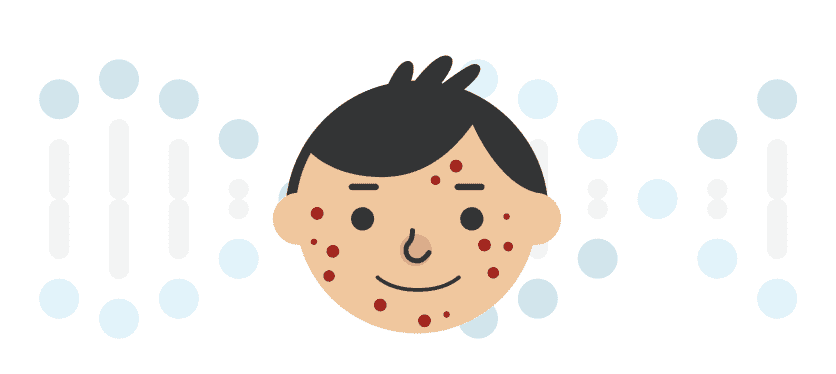Most of us have felt the embarrassment of having an unsightly pimple at the worst possible time, but the impact can be more than just temporary mortification for those with severe acne and instead leave both literal and psychological scars.
About 85 percent of Americans have had acne, and it is estimated that less than 20 percent have experienced moderate to severe acne. While new treatments can help manage the condition and prevent scarring, there remains a lot of misinformation about the causes and best ways to deal with this common skin condition.
A new 23andMe+ Premium report Powered by 23andMe Research looks at a person’s likelihood of developing severe acne and provides information about some of the causes, and some of the ways to reduce the frequency and severity of breakouts. The new report uses machine learning techniques to estimate a person’s likelihood of having severe acne. To make that estimate, we use a statistical model that looks at more than 8,500 genetic variants as well as a person’s ethnicity and sex.
Although it is most common during puberty, acne affects people of all ages. It occurs when hair follicles in the skin become clogged with oil, bacteria, and dead skin cells, which in turn can lead to many deep and painful types of pimples along with many whiteheads and blackheads. To help reduce the frequency and severity of breakouts, experts recommend using gentle skin cleansers, avoiding aggressive scrubbing, and avoiding touching and picking areas prone to acne. Severe acne can be persistent and lead to scarring, especially without proper treatment, which usually includes prescription medication.

Severe Acne
Severe acne often extends deeper into the skin than a mere breakout and can last a lot longer. In these cases, the acne may consist of cysts or nodules that are painful. In addition, after severe acne heals, scars can form. Enlarged and raised scars, called keloids, are more common in people with darker skin. In addition, severe acne may change the color of the skin. It is often associated with changes in hormone levels caused by menstruation, or high levels of androgen hormones, for instance.
While genetics plays a role, other factors such as age and family history can increase the chances of developing acne. Some conditions that are also associated with changes in hormone levels, like polycystic ovary syndrome or congenital adrenal hyperplasia, can also increase the chances of developing severe acne. Certain medications also can play a role.

Taking Action
Understanding more about the genetic and non-genetic factors that may influence your likelihood of having severe acne can help in understanding how to help reduce the frequency and severity of breakouts. Remember to talk with your healthcare provider before making any significant lifestyle changes.
23andMe’s new Severe Acne report (Powered by 23andMe Research) is available to all 23andMe+ Premium members. To learn more about your report, go here.
Not yet a 23andMe+ Premium member? Find out more here.
*The 23andMe Severe Acne report is based on 23andMe research and incorporates more than 8,500 genetic variants to provide information on the likelihood of having severe acne. The report does not account for lifestyle or family history and has not been reviewed by the US Food and Drug Administration.




